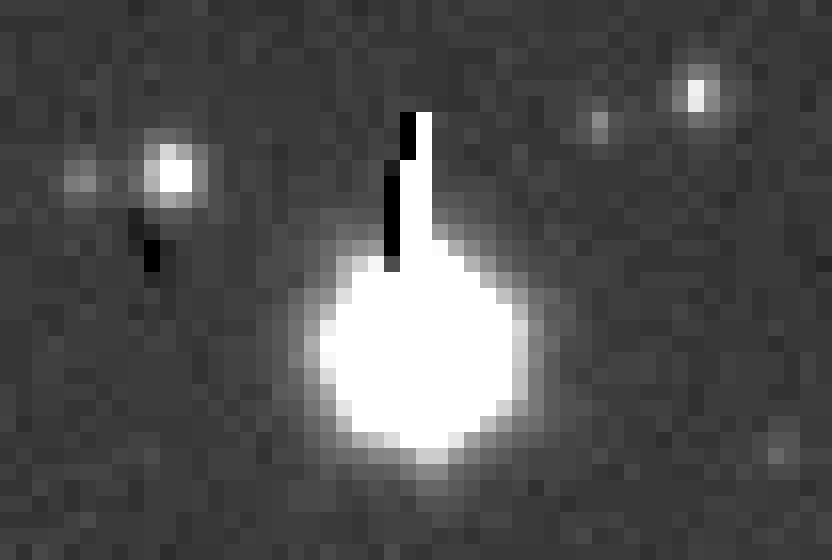 |
Cosmic rays and charge bleeding |
 |
Cosmic rays and charge bleeding |
Below is a small part of a image cropped and expanded from 1996's 09240300. It shows two artifacts worthy of mention.
 One is charge bleeding. When a photon hits a CCD pixel, electronic charge
is registered in that pixel. A single CCD pixel can hold only so much charge,
much like a bucket can hold only so much water. When the bucket gets full,
water spills out. When the pixel gets full, charge spills out. This spillage
of charge is called "bleeding" because it tends to run down the columns (or
up the columns depending on your perspective) like blood seeping from a cut.
Sometimes the overloading of a pixel is so large that the bleeding goes both
up and down. The bright star in the example image is bleeding charge upward
along the rows of the CCD. The black-and-white streak is the bleed trail;
the reason why it is both black and white (not just white) is that the
electronics are overloaded and the data values become very unreliable in
the bleed trail.
One is charge bleeding. When a photon hits a CCD pixel, electronic charge
is registered in that pixel. A single CCD pixel can hold only so much charge,
much like a bucket can hold only so much water. When the bucket gets full,
water spills out. When the pixel gets full, charge spills out. This spillage
of charge is called "bleeding" because it tends to run down the columns (or
up the columns depending on your perspective) like blood seeping from a cut.
Sometimes the overloading of a pixel is so large that the bleeding goes both
up and down. The bright star in the example image is bleeding charge upward
along the rows of the CCD. The black-and-white streak is the bleed trail;
the reason why it is both black and white (not just white) is that the
electronics are overloaded and the data values become very unreliable in
the bleed trail.
The second artifact is due to a cosmic ray interaction with the CCD. When a cosmic ray (a particle from outer space, such as a helium nulceus, for example) interacts with the CCD, it also creates charge in those pixels it passes through. The rate of cosmic ray events in a CCD on earth is approximately 1 per minute per square centimeter. Our CCD is approximately 0.3 square centimeters in area. So we expect a cosmic ray event to be detected approximately once very few minutes. The cosmic rays create charge in the CCD when they pass through, so we expect them to appear as random white spots (typically 1 or a few pixels only). But the cosmic ray event in this example is not white it is black; it is the black spot (or small diagonal streak) just below the two white stars to the left of the bright star. Why is it black?
To understand why the cosmic ray event could be black rather than white like stars, we have to know one important thing about how Stardial is taken:
But (!) if a cosmic ray hits the CCD during the exposure of the image made with the shutter closed (cosmic rays can pass right through the shutter), then the "dark image" has additional charge in those pixels hit by the cosmic ray, so the process of subtraction doesn't work properly for those particular pixels. A cosmic ray interacting with the CCD during the shutter-open image will create a white spot in the difference image (which is recorded and put on the Web). A comsic ray interacting with the CCD during the shutter-closed image will create a black spot in the difference image.